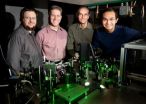The most aggressive forms of breast cancer elude cellular control mechanisms in order to expand
Scientists at IRB Barcelona have provided new data on how certain types of aggressive breast cancer bypass tumor suppression mechanisms
2010-11-25
(Press-News.org) About 30% of breast cancer patients have tumours that show rapid growth and invasion through the body. A common denominator in all of these cases is the presence of a large number of Her2 proteins in tumour cellular membranes. Consequently, these aggressive tumours are referred to as HER2+. Scientists working in the Metastasis Laboratory (MetLab) at IRB Barcelona headed by ICREA researcher Roger Gomis, have described the molecular mechanism that induces HER2+ tumours to ignore the signals that protect cells from excessive growth. The study is published this week in the specialized journal Cancer Research.
Certain external molecules bind to the Her family proteins, thus instructing the cell to divide. However, when cells have multiple copies of the Her2 gene, as is the case of HER2+ patients, they show uncontrolled division and do not respect the signals from their milieu. The prospects for HER2+ patients changed dramatically about ten years ago when the drug Herceptin came onto the market. This agent binds to Her2 to inhibit its proliferative activity, thereby leading to an improved prognosis and greater survival.
LIP disobeys the body's defense system
When cells detect potential harm, they activate a series of protective responses which often lead to cell death or senescence (no growth). All these mechanisms are systems through which the cell can avoid the irreversible errors that lead them to generate tumours. This explains why tumour cells are removed from the body and replaced by healthy ones. In this context, tumour suppression mechanisms are of particular relevance, among these that induced by the hormone TGF-β and the senescence caused by genes that contribute to the development of malignant cells (OIS).
Through experiments using metastatic cells from patients and animal models, the researchers have discovered that Her2 not only accelerates cell division but also evades these cell arrest systems. Her2 stimulates the production of the protein Lip, which deactivates the mechanisms that prevent cell division mediated by TGF-β and the senescence mediated by OIS, thereby leading to accelerated division. "Lip is the baddie in the film. It affects TGF-β and OIS function, both tumour suppression mechanisms", explains Gomis.
Towards more rational drug administration
One of the problems associated with Herceptin is that after long periods of treatment patients begin to develop drug resistance. This study shows that tumour cells that produce an excess of Lip continue to grow in the presence of the drug. This observation indicates that part of the resistance derives from the increase in Lip shown by these individuals.
"In patients that have an alteration in Her2 plus an increase in Lip, treatment with Herceptin may not be as effective. It should be remembered that this drug acts only against the membrane protein Her2", explains Gomis. These discoveries highlight the need to rationalise drug administration, from patient to patient, and to provide new data for the design of novel pharmaceutical agents against cancer that improve its diagnosis and treatment.
INFORMATION:
This study has involved the collaboration of Joan Massagué, Chairman of the Cancer Biology and Genetics Program at the Memorial Sloan-Kettering Cancer Center, New York City, assessor to the MetLab at IRB Barcelona, and adjunct director of the same institute, and has been supported by funding from the BBVA Foundation and the Ministry of Science and Innovation.
END
ELSE PRESS RELEASES FROM THIS DATE:
2010-11-25
In the wake of devastating cholera outbreaks in refugee camps in earthquake-wracked Haiti, a group of leading experts from Harvard Medical School, George Washington University, and the International Vaccine Institute (IVI) have urged the United States to create an emergency stockpile of cholera vaccines for future humanitarian use.
"The costs to the U.S. of creating and maintaining a stockpile of several million doses of cholera vaccine would be low," said the experts in an article published online first on November 24 in The New England Journal of Medicine (NEJM). "But ...
2010-11-25
A new process for creating a personalized vaccine may become a crucial tool in helping patients with colorectal cancer develop an immune response against their own tumors. This dendritic cell (DC) vaccine, developed at Dartmouth and described in a research paper published this week in the journal Clinical Cancer Research, was used after surgical resection of metastatic tumors to try to prevent the growth of additional metastases.
"The results of the study suggest a new way to approach cancer treatment," said Richard Barth Jr., MD, Chief of General Surgery at Dartmouth-Hitchcock ...
2010-11-25
The search is on for insects, mites, microbes or nematodes that could be used in a biologically based approach to controlling silverleaf nightshade, an invasive weed from the Americas that has spread to southern Europe, Africa, India, Australia and elsewhere.
According to U.S. Department of Agriculture (USDA) entomologist Walker Jones, the perennial weed, Solanum elaeagnifolium, is being targeted for its ability to outcompete native plants, reduce crop yields and diminish pasture productivity. Its orange, toxin-producing berries can also poison livestock.
Severe infestations ...
2010-11-25
London, UK, 24 November 2010 – Research from the Laboratory of Psychiatry and Experimental Alzheimers Research (http://www2.i-med.ac.at/psychlab/) at the Medical University Innsbruck (Austria) demonstrated that chronic high fat cholesterol diet in rats exhibited pathologies similar to Alzheimer's disease. The results were published in Molecular Cellular Neuroscience (45(4):408-417, 2010) with lead author Dr. Christian Humpel. The study was co-authored by PhD students, Celine Ullrich and Michael Pirchl, from the same Laboratory.
Alzheimer's disease is a severe neurodegenerative ...
2010-11-25
Mildew infections not only cause unsightly vegetable patches, they can also result in extensive crop failure. Interestingly, the processes involved in infections with this garden pest are similar to those involved in fertilisation. Scientists from the Max Planck Institute for Plant Breeding Research in Cologne and the University of Zurich have identified two proteins in the model plant species Arabidopsis thaliana that are necessary for both fertilisation and infection with powdery mildew. This explains why mildew-resistant plants, in which these genes are mutated, are ...
2010-11-25
Leading experts from the European Society on Clinical and Economic Aspects of Osteoporosis and Osteoarthritis (ESCEO) and the International Osteoporosis Foundation (IOF) have published a timely position paper on the association between subtrochanteric femoral (upper thigh bone) fractures and long-term treatment with bisphosphonates.
Bisphosphonates are the most common drug therapy for osteoporotic fracture prevention, prescribed to millions of people around the world. Concern among doctors and patients has arisen following recent media reports that cite a possible association ...
2010-11-25
CAMBRIDGE, Mass. -- In a new study to be published in the Nov. 25 issue of Nature, MIT cancer biologists show that restoring the protein p53's function in mice with lung cancer has no effect early in tumor development, but restoring the function later on could prevent more advanced tumors from spreading throughout the body.
Cancer researchers have known since the 1980s that p53 plays a critical role in protecting cells from becoming cancerous. P53 is defective in about half of all human cancers; when it functions correctly, it appears to suppress tumor formation by preventing ...
2010-11-25
CHAMPAIGN, Ill. – The long, anxious wait for biopsy results could soon be over, thanks to a tissue-imaging technique developed at the University of Illinois.
The research team demonstrated the novel microscopy technique, called nonlinear interferometric vibrational imaging (NIVI), on rat breast-cancer cells and tissues. It produced easy-to-read, color-coded images of tissue, outlining clear tumor boundaries, with more than 99 percent confidence – in less than five minutes.
Led by professor and physician Stephen A. Boppart, who holds appointments in electrical and computer ...
2010-11-25
MEDFORD/SOMERVILLE, Mass. -- Some of the universe's most massive galaxies may have formed billions of years earlier than current scientific models predict, according to surprising new research led by Tufts University. The findings appear in the Astrophysical Journal published online Nov. 24 in advance of print publication on Dec. 10, 2010.
"We have found a relatively large number of very massive, highly luminous galaxies that existed almost 12 billion years ago when the universe was still very young, about 1.5 billion years old. These results appear to disagree with ...
2010-11-25
Children living in disadvantaged neighbourhoods are more likely to succeed if they participate in a community-based prevention program, according to findings released recently from a multi-year research study based at Queen's University.
Children participating in the Better Beginnings, Better Futures (BBBF) project showed improved social and academic functioning. The project also impacted positively on families and on neighbourhoods.
"The results from our study indicate that the project has been a success," says Queen's psychology professor emeritus Ray Peters, the ...
LAST 30 PRESS RELEASES:
[Press-News.org] The most aggressive forms of breast cancer elude cellular control mechanisms in order to expand
Scientists at IRB Barcelona have provided new data on how certain types of aggressive breast cancer bypass tumor suppression mechanisms

